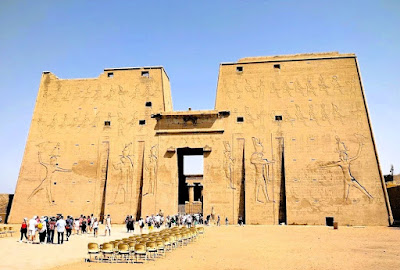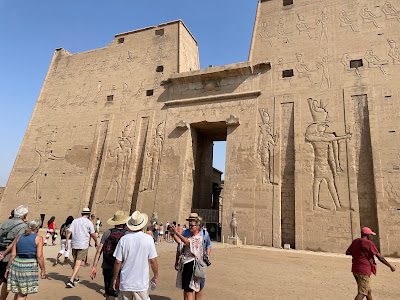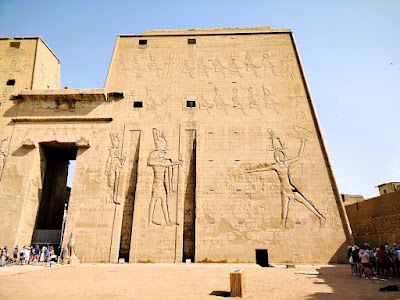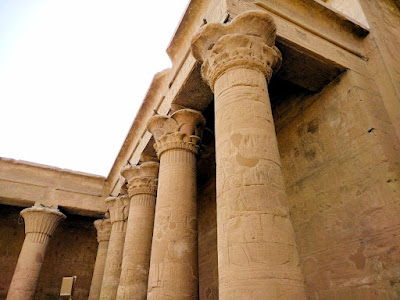In fact, just looking at all our photos, which did not capture everything, and writing about legends we had heard, I was ready to take a break from blogging about Egypt, with a Day Trip to the Poconos as a welcome recess.
Back to Egypt, we were happy to know that during the hottest part of the day we would be taking a break to have lunch and relax on a short cruise between historical site excursions.
The excellent preservation can be attributed to the fact that it fell into disuse around with the emergence of the Christian Roman era at the tail of the 4th Century AD.
Over the following centuries, 39 feet of drifting sand and Nile River silt buried most of the massive structure. Napoleon's expedition in 1798 noted the uppermost temple pylons, leading to the re-discovery in 1860 by the French Egyptologist Auguste Mariette.
As we touched on briefly in Temples of Karnak and Luxor, Alexander the Great had conquered Egypt and made himself Pharaoh. When he died, his general in that region assumed rule of Egypt, making himself Pharaoh Ptolemy I.
Ptolemy and his successors would for the most part rule as Greeks, but in a nod to Egyptian traditions, they built a huge Egyptian temple over a 180-year period that started under Ptolemy III in 237 BC and completed under Ptolemy XII in 57 BC. The fact that they could build such an incredible temple is monument to how wealthy Egypt remained under their rule.
They built near an early New Kingdom temple constructed during the reigns of Pharaohs Seti, Ramses I and Ramses II.
I would guess that Ptolemy III was approached by priests from this outpost far from the city of Alexandria where he lived and ruled over Egypt, complaining about the condition of the original temple. As our Episcopal Rector Joel recently lamented, his job is more about overseeing maintenance on the beautiful church building than what he imagined the ministry would be.
While it is a temple to honor the Egyptian falcon god Horus, it was likely more homage to the tradition of Pharaohs building grand, enduring projects as proof of their wealth and awesome powers.
The Temple at Edfu is the second largest temple in Egypt.
In these photos, you can see that the artwork is still very much in the style developed under Pharaoh Snefaru or even the first Pharaoh Narmer.
Horus was represented by a falcon or sometimes a falcon with the body of a human.
There are many legends associated with Horus, his father Osiris, his mother Isis and his uncle/arch nemesis Seth.
Basically, Seth represents evil, and Horus good, a tale as old as time.
After failing several times in rather dramatic fashions in other legends --- like tearing Osiris into several pieces which his wife Isis reassembles, except his penis which had been eaten by a fish --- Seth finally kills Osiris with the intention to rule in his stead.
Of course, Horus was the heir apparent, and to paraphrase a Disney movie that I would say is based on this legend, he "just can't wait to be king."
They battle over and over again --- far more times than a modern audience for "The Lion King" movie or stage version would sit through --- and of course Simba...I mean Horus wins. Good conquers evil in the end.
But this is Egypt, not a Hollywood movie, so the battle between Horus and Seth keeps getting revisited again and again. Go Horus!
Horus became an important symbol of a Pharaohs right to rule. The falcon wings or head are often seen on statures of Pharaohs, and in pictographs the falcon-headed humanoid shows his approval of a Pharaoh, who would be fashioned after the current ruler, and sometimes be reshaped to look like his replacement.
Justification for making the change was seen as prerogative of embodying the essence of the Pharaoh.
By the time we had free time after Fawzy's presentation and guided tour to explore on our own, we were all ready to return to the ship for the afternoon cruise.
Fawzy said he would be making a presentation about modern Egypt's government, culture and economy after lunch for any who wanted to attend. Normally, we are all in for that type of seminar on a cruise, but the idea of relaxing in our air-conditioned room, reading and occasionally looking out our wall of windows as we drifted along the Nile, was too tempting.
We were refreshed by the time we arrived at our afternoon destination Kom Ombo.










































No comments:
Post a Comment